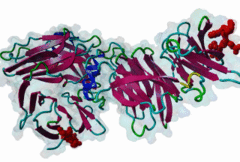| Accession: | |
|---|---|
| Functional site class: | Clathrin box |
| Functional site description: | Clathrin boxes are found on cargo adaptor proteins. They interact with the N-terminal beta-propeller structure of Clathrin heavy chain. Beside the "classical" motif, some variants have been described for various types of adaptor proteins. The same protein can bear several subtypes of Clathrin boxes. |
| ELMs with same func. site: | LIG_Clathr_ClatBox_1 LIG_Clathr_ClatBox_2 |
| ELM Description: | The classical clathrin box is a motif found on cargo adaptor proteins, in general near their C-terminus. This motif is sufficient for binding to the amino terminal beta propeller structure of Clathrin heavy chain. Variants of this "classical" consensus exist (see LIG_Clathr_ClatBox_2 for example) sometimes they coexist on the same protein. |
| Pattern: | L[IVLMF].[IVLMF][DE] |
| Pattern Probability: | 0.0003406 |
| Present in taxons: | Eukaryota Homo sapiens Mus musculus Rattus norvegicus Saccharomyces cerevisiae |
| Interaction Domain: |
Clathrin_propel (PF01394)
Clathrin propeller repeat
(Stochiometry: 1 : 1)
|
Clathrin is the main component of the coat that decorates the cytosolic face of carrier vesicles mediating protein and lipid transport in the endocytic and late secretory pathways. In vivo the multimerisation of the clathrin heterohexamer (known as triskelion) and the clathrin-mediated vesicular trafficking are regulated through a complex network of interactions involving clathrin and a number of accessory proteins. Clathrin boxes are 5-residue-motifs found on cargo adaptor proteins, mostly near their C-terminus or central region. They are found in a large variety of accessory proteins involved in endocytosis and vesicular trafficking (specific adaptors like beta-arrestin and more general adaptor proteins like AP complexes). Unfolded flexible regions or hinges can display multiple copies of the motif, sometime belonging to different subtypes. This organisation is believed to ensure a complex, ajustable network of "weak" cooperative interactions, with the affinity between members defined by the number of motifs they possess. Extended peptides could also promote clathrin assembly by bridging the heavy chains of clathrin molecules engaged in an assembled coat. Clathin box motifs interact with the N-terminus of Clathrin heavy chain, with the so called beta-propeller structure. |
(click table headers for sorting; Notes column: =Number of Switches, =Number of Interactions)
Please cite:
ELM-the Eukaryotic Linear Motif resource-2024 update.
(PMID:37962385)
ELM data can be downloaded & distributed for non-commercial use according to the ELM Software License Agreement
ELM data can be downloaded & distributed for non-commercial use according to the ELM Software License Agreement

